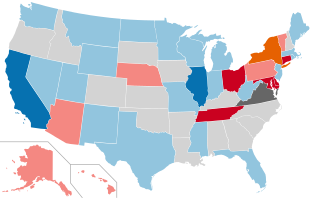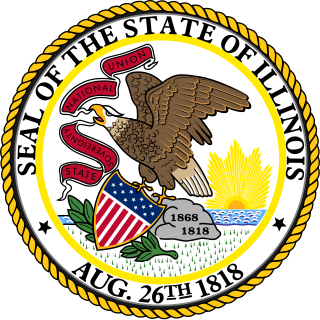
The 1970 United States Senate elections was an election for the United States Senate. It took place on November 3, with the 33 seats of Class 1 contested in regular elections. Special elections were also held to fill vacancies. These races occurred in the middle of Richard Nixon's first term as president. The Democrats lost a net of three seats, while the Republicans and the Conservative Party of New York picked up one net seat each, and former Democrat Harry F. Byrd Jr. was re-elected as an independent.

The 1968 United States Senate elections were elections for the United States Senate. Held on November 5, the 34 seats of Class 3 were contested in regular elections. They coincided with the presidential election of the same year. The Republicans picked up five net seats in the Senate. This saw Republicans win a Senate seat in Florida for the first time since Reconstruction.

The 1964 United States Senate elections were held on November 3. The 33 seats of Class 1 were contested in regular elections. Special elections were also held to fill vacancies. They coincided with the election of President Lyndon B. Johnson by an overwhelming majority, to a full term. His Democratic Party picked up a net two seats from the Republicans. As of 2023, this was the last time either party has had a two-thirds majority in the Senate, which allowed the Senate Democrats to override a veto, propose constitutional amendments, or convict and expel certain officials without any votes from Senate Republicans. However, internal divisions would have prevented the Democrats from having done so. The Senate election cycle coincided with Democratic gains in the House in the same year.

The 1910–11 United States Senate election were held on various dates in various states. As these U.S. Senate elections were prior to the ratification of the Seventeenth Amendment in 1913, senators were primarily chosen by state legislatures. Senators were elected over a wide range of time throughout 1910 and 1911, and a seat may have been filled months late or remained vacant due to legislative deadlock. However, some states had already begun direct elections during this time. Oregon pioneered direct election and experimented with different measures over several years until it succeeded in 1907. Soon after, Nebraska followed suit and laid the foundation for other states to adopt measures reflecting the people's will. By 1912, as many as 29 states elected senators either as nominees of their party's primary or in conjunction with a general election.

Thomas Joseph Spellacy was an American politician and lawyer. He was the 47th Mayor of Hartford, Connecticut, held several other offices, and was one of Connecticut's most prominent Democrats over a period of more than 50 years.

Elections for state and federal offices for the 2010 election cycle in Connecticut, US, were held on Tuesday, November 2, 2010. Any necessary primary elections for the Republican and Democratic parties were held on Tuesday, August 10, 2010.

The 1956 United States Senate election in Connecticut was held on November 6, 1956.

The 1952 United States Senate election in Wisconsin was held on November 4, 1952.

The 1952 United States Senate special election in Connecticut was held on November 4, 1952, to fill the vacancy left by the death of Brien McMahon.

The 1916 United States Senate election in Connecticut was held on November 7, 1916. Incumbent Republican Senator George P. McLean was re-elected to a second term in office over Democratic State Attorney Homer Stille Cummings.

The 1914 United States Senate election in Colorado took place on November 3, 1914. It was the first direct U.S. Senate election in Colorado following the ratification of the Seventeenth Amendment. Incumbent U.S. Senator Charles S. Thomas, a Democrat, who was first elected by the state legislature to fill a vacancy in 1913, ran for re-election to a full term.

The United States Senate election of 1922 in New Jersey was held on November 7, 1922.

The 1922 United States Senate election in Minnesota took place on November 7, 1922. Farmer–Labor challenger Henrik Shipstead defeated incumbent Republican U.S. Senator Frank B. Kellogg and Democratic challenger Anna Dickie Olesen.

The 1928 United States Senate election in Connecticut was held on November 6, 1928. Incumbent Republican Senator George P. McLean was not a candidate for re-election. In his place, Republican State Senator Frederic C. Walcott won the seat against former U.S. Representative Augustine Lonergan.

The 1944 United States Senate election in Connecticut was held on November 7, 1944.

The 1972 United States Senate election in Louisiana was held on November 9, 1972.
A Massachusetts general election was held on November 6, 1956, in the Commonwealth of Massachusetts.
A Massachusetts general election was held on November 2, 1954 in the Commonwealth of Massachusetts.

The 1918 Connecticut gubernatorial election was held on November 5, 1918. Incumbent Republican Marcus H. Holcomb defeated Democratic nominee Thomas J. Spellacy with 50.72% of the vote.

Elections were held in Illinois on Tuesday, November 3, 1936.






















